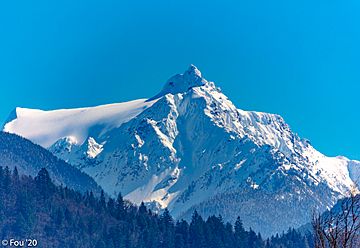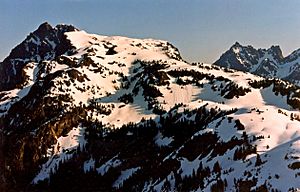Tomyhoi Peak facts for kids
Quick facts for kids Tomyhoi Peak |
|
|---|---|

Tomyhoi Peak seen from Canada
|
|
| Highest point | |
| Elevation | 7,439 ft (2,267 m) NAVD 88 |
| Prominence | 2,035 ft (620 m) |
| Isolation | 2.46 mi (3.96 km) |
| Parent peak | Mount Larrabee |
| Geography | |
| Location |
|
| Parent range | North Cascades |
| Topo map | USGS Mount Larrabee |
| Climbing | |
| First ascent | 1927 Lage Wernstedt |
| Easiest route | Scrambling |
Tomyhoi Peak is a mountain in the Skagit Range that stands 7,439 feet (2,267 meters) tall. It is located in the North Cascades of Washington state, about one mile south of the Canada–United States border. This peak is found west of Mount Larrabee and is part of the Mount Baker Wilderness. This wilderness area is within the Mount Baker-Snoqualmie National Forest. The name "Tomyhoi Peak" was officially recognized in 1913 by the U.S. Board on Geographic Names.
The closest taller mountain is Canadian Border Peak, which is about 2.4 miles (3.9 km) to the northeast. Water flowing from the east side of Tomyhoi Peak goes into Tomyhoi Lake and Tomyhoi Creek. Water from the west side drains into Damfino Creek. An unofficial glacier, called Tomyhoi Glacier, sits on the mountain's north side. From the top of Tomyhoi Peak, you can see amazing views of Mount Larrabee, American Border Peak, Canadian Border Peak, Mount Shuksan, and Mount Baker.
Getting to Tomyhoi Peak
You can reach Tomyhoi Peak by using the Keep Kool Trail (Trail #699). To get to the trailhead, you'll drive on Twin Lakes Road (Forest Service Road #3065). This road is off the Mount Baker Highway. The first 4.5 miles (7.2 km) of the trail are well-maintained.
Weather at Tomyhoi Peak
Tomyhoi Peak is in a marine west coast climate zone. This means it has mild, wet winters and cool, drier summers. Most of the weather systems that bring rain or snow start over the Pacific Ocean. They then travel northeast towards the Cascade Mountains.
When these weather systems reach the North Cascades, the tall peaks force the air upward. As the air rises, it cools and drops its moisture as rain or snowfall. This process is called Orographic lift. Because of this, the western side of the North Cascades gets a lot of rain and snow, especially in winter.
Due to the mild climate and closeness to the Pacific Ocean, temperatures rarely go below 0°F (-18°C) or above 80°F (27°C) west of the Cascade mountain tops. In winter, it's often cloudy. However, in summer, high-pressure systems over the Pacific Ocean usually bring clear skies. Because of the ocean's influence, the snow here tends to be wet and heavy. This can lead to a high risk of avalanches.
How Tomyhoi Peak Was Formed

The North Cascades have some of the roughest land in the Cascade Range. You'll find jagged peaks, sharp ridges, and deep valleys carved by glaciers. The amazing shapes of the land and the big changes in elevation happened because of geological events millions of years ago. These events also caused different climates across the Cascade Range.
The Cascade Mountains started forming millions of years ago, during the late Eocene Epoch. At that time, the North American Plate was slowly moving over the Pacific Plate. This movement caused many volcanic eruptions. Also, small pieces of the Earth's crust, called terranes, joined together to create the North Cascades about 50 million years ago.
During the Pleistocene period, which began over two million years ago, glaciers repeatedly moved forward and backward. These glaciers carved and shaped the landscape. The U-shaped valleys you see today were formed by these recent glaciers. The rising of the land (called uplift) and cracks in the Earth's crust (called faulting), combined with the action of glaciers, are the main reasons for the tall peaks and deep valleys in the North Cascades area.




